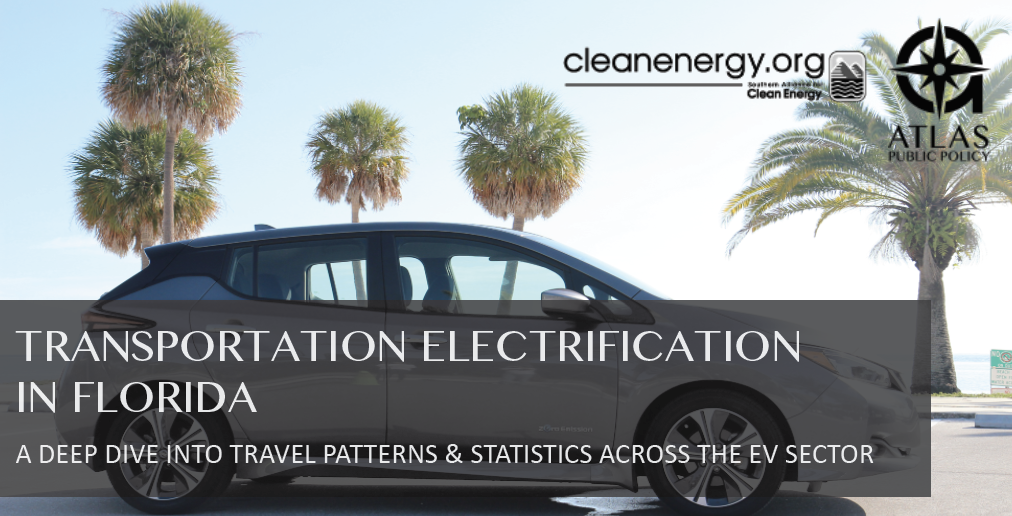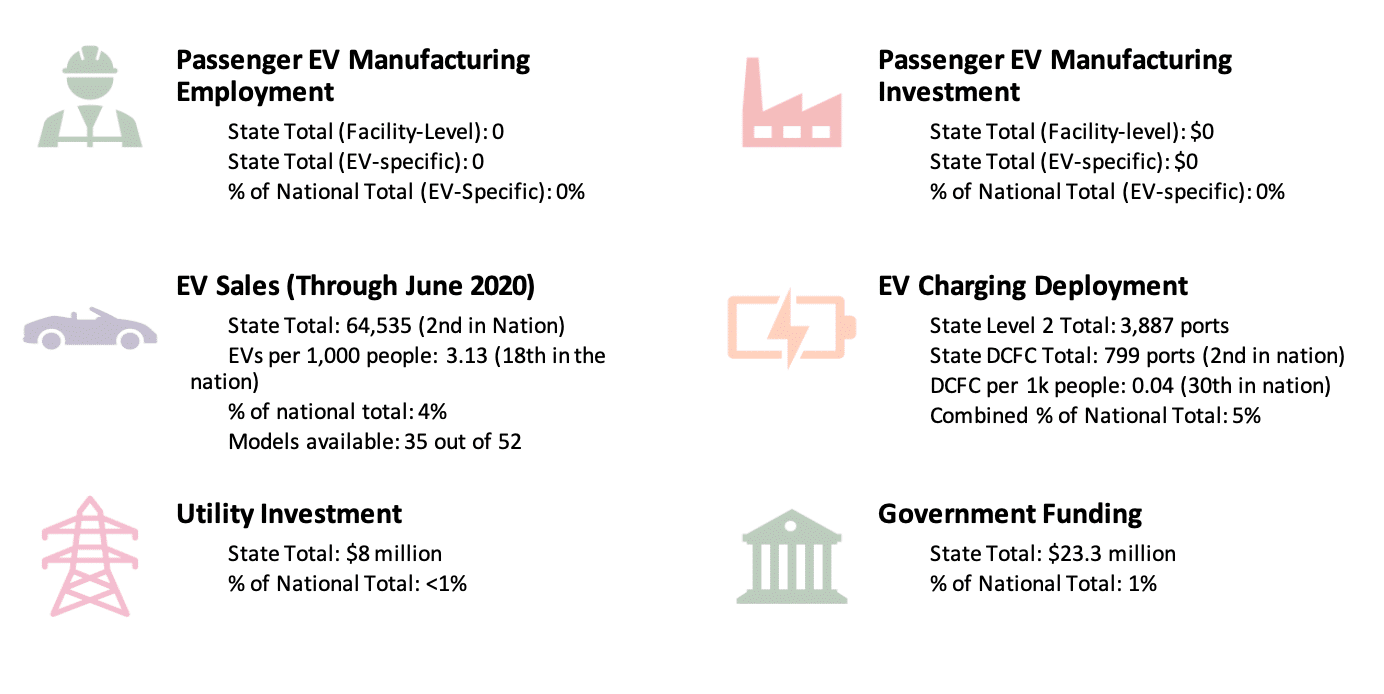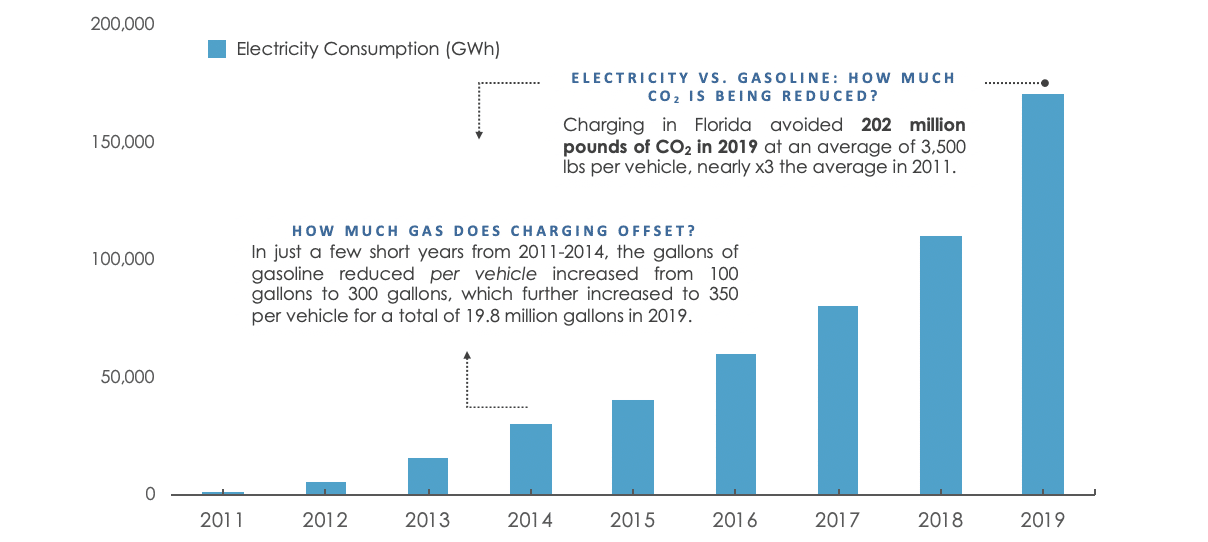Florida is #2 in the nation in electric vehicle (EV) sales, but near the bottom in utility investment. The state also lags other states in EV charger deployment. Utility engagement is needed to ensure Floridians can fully access the economic, public health, and climate benefits that EVs deliver.
Stan Cross | October 20, 2020 | Clean Transportation, Electric Vehicles, FloridaStates across the country, including Florida, are seizing the opportunity to increase EVs and EV charging stations. Cumulatively, 1.6 million passenger EVs have been sold, and investment in the EV sector is rising. Transportation electrification is taking hold in the United States across all vehicle types, including consumer vehicles, fleets, electric buses, and trucks.
To explore how Florida stacks up against other states, the Southern Alliance for Clean Energy (SACE) and Atlas Public Policy have collaborated on a new brief, “Transportation Electrification in Florida.” The new brief follows the recent “Transportation Electrification in the Southeast,” a collaboration between SACE and Atlas, which examined state policy, regulatory, economic development, and investment activity across the Southeast. The Florida-specific brief provides a snapshot of Florida’s EV market, transportation patterns, policy environment, and opportunities to improve public health, meet climate change goals, and spur economic growth. This blog is the second in a series examining the study’s findings. The first discussed the economic, public health, and climate benefits electric transportation offers for Floridians, and the third and final blog will look in greater detail at how lawmakers can advance policies to accelerate engagement and investment, enabling all Floridians to access this myriad of benefits.

Download the Brief
Read the Blog Series
One of Florida’s Biggest EV Levers: Investor-Owned Utility Engagement
Florida is #2 in the nation in passenger EV sales. As of June 2020, there were roughly 64,500 EVs on Florida’s roads. EV sales in the state increased by 20% between 2018 and 2019, despite a 12% drop in EV sales nationwide during the same period. However, when looked at on a per capita basis, Florida ranks 18th nationally in EV sales, indicating significant room for market growth.
But Florida continues to lag other states in the nation in government and utility funding for transportation electrification and per capita deployment of EV charging infrastructure. To date, Florida’s investor-owned utility (IOU) investments represent less-than-1% of IOU investments nationwide, government funding represents approximately 1%, and Florida ranks 30th in EV charger deployment per capita. These statistics indicate that Florida has room to improve.
EV INDICATORS IN FLORIDA THROUGH AUGUST 2020

Activating state and utility engagement and building out needed charging stations will further advance Florida’s EV market leadership and provide Floridians access to electric transportation’s economic, public health, and climate benefits. Given the multitude of benefits EV adoption at the consumer and fleet-level offer to Floridians — including improved public health, consumer savings, retained wealth, downward pressure on electric utility rates, reduced climate change risk, and increased energy security — regulators and lawmakers should encourage and support utility engagement to help meet Florida’s charging infrastructure and EV market needs.
With the passage of Senate Bill 7018, the Florida Legislature and Governor DeSantis took the first step in activating utility engagement. The state law tasks the Public Service Commission (PSC), Department of Transportation (DOT), and the state Energy Office to lead the creation of an EV master plan. A critical part of the planning process is determining what constitutes appropriate and necessary utility engagement. Without guidance from lawmakers and regulators, utilities and the market are left uncertain what roles and programs Florida’s regulated utilities will be permitted to engage. Determining appropriate principles and guidelines for utility engagement and investment, like those suggested by Edison Electric Institute, will provide greater certainty for utilities, stakeholders, and the market.
Roles Utilities Can Play
As the Transportation Electrification in Florida brief highlights, the state’s three large IOUs have begun to engage:
- Duke Energy Florida is implementing its $8 million PSC-approved Park and Plug program that has installed 500 EV chargers across its territories.
- Florida Power & Light (FPL) implemented its self-funded EVolution program to install and operate 1,000 charging stations across its territories. Also, FP&L has filed a petition before the PSC to run an EV pilot project that will allow address demand charges, a market barrier that impedes private sector EV charger deployment.
- Tampa Electric Company (TECO) recently filed a petition before the PSC requesting approval to install 200 charging stations across its territory.
The Regulatory Assistance Project policy guide outlines four charging infrastructure roles utilities are suited to play. Optimal solutions result from utilities engaging in all of these roles under various circumstances, when and where doing so is beneficial to the market and consumers:
Facilitator: The utility provides electric service when and where requested but not engaging directly in the business of vehicle charging.
Enabler: The utility deploys traditional electrical infrastructure up to the point of connection to charging stations but does not take a direct role in installing, owning, or operating the charging infrastructure.
Manager: In addition to delivering electric service to the vehicle charger’s location, the utility manages the charging operation to accommodate grid capabilities and grid needs.
Provider: The utility delivers electric service to the charging equipment, which the utility owns and can earn a return on, and the utility provides charging services.
Examples of Utility Engagement Opportunities
Utilities are well-positioned to help overcome several market barriers, including filling charging infrastructure deployment gaps, researching and developing grid-related technical solutions, addressing rate design challenges, and educating consumers. At this early market stage, utilities need to invest in pilot programs to understand better how best to overcome these barriers and prepare for scale as light, medium, and heavy-duty EVs reach mass-market penetration over the coming decade.
While utility engagement should not be limited to these specific opportunities, regulators and lawmakers should encourage and support utility efforts to address them:
Provide EV charging infrastructure at locations underserved by private sector-funded charging station deployment.
- Rural and traditionally disadvantaged communities
- Evacuation route and highway corridor charging gaps
- Commercial downtown districts
Manage and enable EV charging where utility capabilities, capacity, and capital are needed.
- Make-ready investments for multifamily dwellings and public fast charging
- Managed charging programs to explore vehicle-to-grid integration and distributed energy resource optimization
- Residential charging program for low-income customers
Test optimal rate-design, investment strategies, and consumer outreach to facilitate market growth.
- DCFC demand charge limiters to support private sector EV charger deployment
- Light, medium, and heavy-duty time of use rates to encourage off-peak charger utilization and other grid management priorities
- Programs for funding electric transit and school buses
- Awareness campaigns to ensure all customers understand EV ownership benefits and available incentives
Now is the Time To Pull The Lever
Today, Florida depends on imported oil for transportation: the state imports 100% of the oil consumed and lacks economic and workforce development benefits from oil industry-related investments or jobs. When consumers and fleet operators purchase gas at the pump, nearly all of the post-tax dollars spent are siphoned away from Florida to oil company corporate headquarters and foreign nations. In contrast, when Florida’s EV drivers buy locally produced electricity to fuel their mobility, they pay less (leaving dollars in their pocket to spend elsewhere), AND what they do spend goes to Florida-based utilities.
Florida voters banned off-shore drilling in state waters. The federal government recently backed them up, expanding a moratorium on drilling in federal waters along the state’s Gulf and Atlantic coasts. Thus, the state’s dependence on imported oil is unlikely to change. The sooner the state transitions to electric transportation, the sooner it can shift to reliance on Florida-made electricity and enhance transportation energy security for all Floridians.
ELECTRICITY CONSUMED FROM EV CHARGING IN FLORIDA

This chart shows the growth in electricity consumption as a result of increased EV adoption in Florida. EVs reduce vehicles’ carbon intensity because electricity consumed from charging is far cleaner than the gasoline used to power conventional passenger vehicles.
Along with the shift to EVs retaining Floridians’ wealth in-state and enhancing energy security, EVs end tailpipe emissions and improve public health. According to a recent report by the American Lung Association, transitioning to an all-electric fleet nationwide by 2050 would save 6,300 lives and cut greenhouse gas emissions by 1.4 billion metric tons. It would also save $72 billion in healthcare costs nationally, including $3.7 billion in Florida.
To realize the economic, public health, and climate benefits of electric transportation in the coming decades, Florida needs to take action today. The transition to light, medium, and heavy-duty EVs will take time. Every internal combustion car, truck, and bus purchased in the meantime becomes another costly, public health-compromising, and climate-change inducing problem to deal with.
Utility engagement is critical to accelerating Florida’s transition to EVs. Without the states’ IOU’s capital, capacity, and capability fully engaged, the transportation electrification benefits awaiting Floridians will not arrive anytime soon.
Check out the other blogs in this series:
Read Part 1, “Transportation Electrification in Florida: Opportunities are Bright, Could Be Brighter,” for an overview of the Transportation Electrification in Florida Brief.
Read Part 3, “Transportation Electrification: State Policies Will Drive Growth,” which addresses the state policies Florida lawmakers can implement to support equitable access to electric transportation.
The Southern Alliance for Clean Energy’s ‘Electrify the South’ campaign advocates for a shift to clean, electric transportation throughout the Southeast. Visit ElectrifytheSouth.org to learn more and connect with us.
#EVsinFL